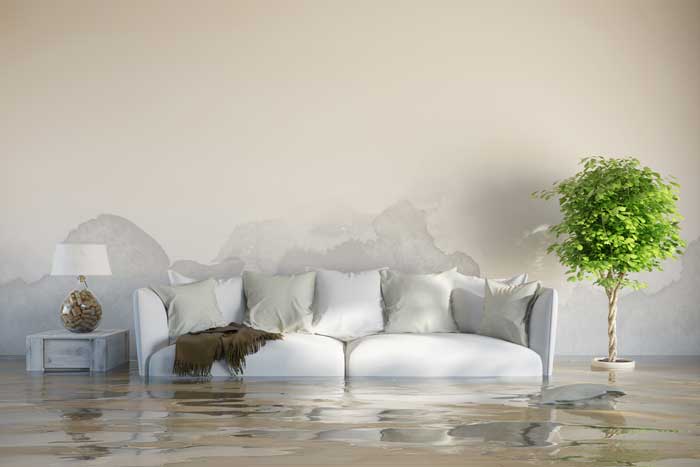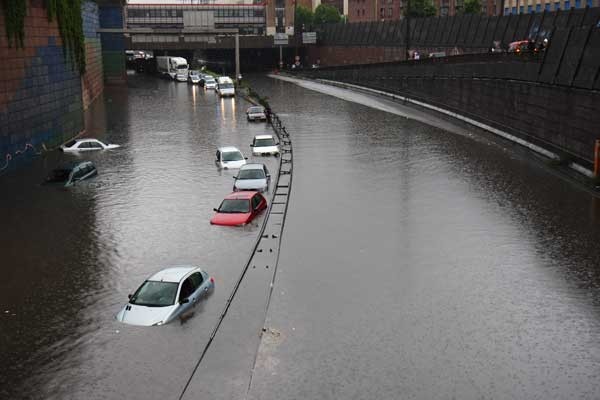Blog
Water, Water Everywhere: How to Prevent the Avoidable Home Flood
Learn what preventative measures you can take to minimize and prevent water damage altogether, and protect your assets and your time.
Imagine: You've gone away on vacation, and return home to standing water, musty smells, and damaged property. A burst pipe has flooded your home—what do you do?
Many of us may not think of it this way, but water damage can sometimes be more destructive than fire. Water seeps into every nook and cranny of a structure, and can go unnoticed for days or weeks. This can lead to mold growth, which is not only a hassle to deal with, but also potentially toxic.

Homeowners default to insurance as a safety net, but there are preventative measures you can take to minimize and prevent water damage altogether, and protect your assets and your time.
The Various Costs of a Home Flood
Often, when homeowners think of home flooding, they think about the flooding that occurs in a natural disaster but ignore the all-too-common threat of faulty plumbing or a pipe bursting from the cold weather.
As a result, turning off the house's water supply when away isn't usually a top priority, and vacation properties might sit for months without anyone checking up. This makes you particularly vulnerable to the consequences of a home flood.
Here are just a few of the scenarios that can lead to a flood on your property:
- Extremely low temperatures cause the water in your pipes to freeze, expand, and burst.
- Your pool gets a leak, which floods the backyard and your basement.
- A backup causes your washing machine or sewage system to overflow into your basement.
- Heavy rain damages the roof and water gets into the house.
- A nearby body of water overflows and inundates your street, your yard, and your home.
The costs of a flood range from financial and time investments to emotional. You'll deal with insurance claims and possible out-of-pocket costs, as well as numerous inconveniences. Worse, things might be lost that simply can't be replaced. On top of all that, your home could actually become a health hazard.
Consider just some of the inconveniences you might face in the wake of a home flood:
- Moving furniture and other belongings into storage so the house can be restored
- Obtaining estimates for restoration and rebuild
- Waiting for contractor schedules, supplies and more, which is more difficult if it's a busy time of year or around the holidays
- Living somewhere else while your home is made safe and clean, which can take days or even weeks
- Losing items in the transfer between the home and storage facility
- Organizing the various financial and insurance processes
- Lingering damp smells in the home, even after restoration
- Dealing with mold that's not only unpleasant but can be toxic to family health
Remember, this can happen to anyone at any time of year. The best way to avoid the costs of a home flood is to take preventive measures before disaster strikes, and have a plan of action for when it does.
Manage Risk before You Need Insurance
There's no guarantee that you can stop a flood. However, certain things can minimize risk and even make the aftermath a little easier. Before the insurance company has to step in, consider some preventative measures.
If you have a property that isn't being used, such as a vacant rental property or a vacation home, turn off the water, and ensure someone is checking on the home on a regular basis. For all of your properties, go over a checklist for the season, especially the cold season of winter.
Consider installing some protective devices around the house, such as:
- Reinforced hoses: The addition of stainless steel mesh makes the hoses of your washing machine and dishwasher less prone to breaking.
- Insulation: Plumbing located within exterior walls, in attics, and in unheated crawl spaces is most vulnerable to freezing or bursting. Ensure all pipes are insulated or have wall insulation around them to protect against possible freezing.
- A pressure-testing gauge: This will test your home's water pressure to let you know if it needs to be reset.
- Water detectors: These battery-powered sensors can be installed in those rooms that are most likely to be the source of the water loss, such as kitchens and bathrooms. These sensors can be monitored via a central-station alarm.
- Automatic water shut-off valve and sensor: The shut-offs can be installed for just your washing machine or other appliances when they're not in use. More sophisticated systems can turn off the water for the entire house, which can be very handy if a pipe bursts.
Keep an eye on leaks as well, and address even minor issues so that they don't turn into larger problems:
- Turn off the water to your house, look for places where it's still flowing, then investigate.
- Check your water bill. If it's suddenly higher, look for spots of unintended water loss.
- Look for water seepage even where there isn't any plumbing. If rain or groundwater is getting in somewhere, it's time to address that.
If a flood does happen in your home, shut off the water, turn off utilities and don't use electricity in wet areas. Get any furniture, rugs, and other belongings out quickly. Remove water where you can and turn on fans to circulate the air. Contact a water cleanup specialist such as Servpro—quick intervention could limit the damages.
Finally, file your claim as quickly as possible and save your receipts related to any repairs or services.
There's a lot to think about when it comes to preventing and dealing with home flooding. However, putting in the effort now could save you a lot of time, effort and money if the worst happens. For more information about how you can mitigate the risk of and recover from flooding, reach out to us at Woodruff Sawyer.
Table of Contents








